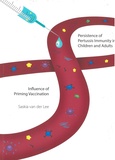Persistence of Pertussis Immunity in Children and Adults
Influence of Priming Vaccination

Lee, Saskia van der
- Promoter:
- Prof.dr. E.A.M. (Lieke) Sanders
- Co-promoter:
- Dr. A.M. (Annemarie) Buisman & dr. G.A.M. (Guy) Berbers
- Research group:
- Sanders
- Date:
- April 5, 2018
- Time:
- 12:45 h
Summary
Pertussis, or whooping cough, is a highly contagious infection of the upper respiratory tract and may cause severe clinical disease, particularly in young unvaccinated infants. Despite a consistent high pertussis vaccination coverage, pertussis re-emerged in the late 1990s, with cyclic outbreaks reported every 2–3 years in the Netherlands, the USA, Australia and other countries. Epidemiological studies indicate a more limited protection against clinical pertussis in young individuals primed with acellular pertussis (aP) vaccines in infancy compared with whole-cell pertussis (wP) primed youngsters. The emerging pertussis outbreaks, the steadily increased notifications in all age groups and increasing number of pertussis related deaths in unvaccinated infants stress the importance of improved pertussis vaccines. Since the development of new vaccines will take many years, adaptation of the current pertussis vaccination schedules may contribute to reduce the current pertussis burden. Several countries recommend aP booster vaccinations for adolescents, adults and pregnant women, in addition to the pre-school aP booster. The long-term immunological responses to booster vaccinations in these age groups are however currently unknown. The main objective of this thesis was to determine and compare the long-term humoral and cellular immune responses after one or two aP booster vaccinations in pre-adolescents, primed in infancy with wP or aP vaccines, and in wP-primed adults. We observed that an additional aP booster vaccination at age 9 years increased pertussis-specific IgG antibody levels and numbers of memory B-cells, which were higher in children primed with wP vaccines compared with aP-primed children. Moreover, the production of cytokines by pertussis-specific T-cells did not increase upon the extra booster. Surprisingly, Th1 cytokine levels, considered to play an important role in long-term protection against pertussis, were higher in wP-primed children while the Th2 cytokine levels were similar between the two groups and resulted in a Th2-skewed immune response in aP-primed children. These results were consistent with our findings of higher proportions of pertussis-specific IgG4 antibodies found after aP-priming compared with wP-priming. The type of pertussis vaccines administered at infant age affects the immunological imprinting and subsequently the protection against pertussis until at least adolescence, explaining the better protection against clinical pertussis found in wP-primed adolescents. We also evaluated the immune response to a first aP booster vaccination in adults primed with wP vaccines in the first year of life. The immunogenicity of this first booster proved robust resulting in pertussis-specific IgG levels, numbers of memory B-cells and Th1, Th2, and Th17 cytokine levels that remained higher for up to 2 years compared with pre-booster levels, and will most likely confer protection against pertussis. The estimated duration of pertussis toxin-IgG antibody levels above the presumed protective cut-off for approximately 9 years indicates the induction of long-lived plasma cells that maintain these systemic antibody levels. We assessed the Bordetella pertussis acquisition rate in Dutch adolescents during the large pertussis outbreak of 2012 in the Netherlands. We demonstrated that 10% of the study participants became sub-clinically infected with B. pertussis during the 2012 outbreak, indicating a large reservoir of B. pertussis in this age group. Importantly, we highlighted that using the current pertussis toxin-IgG cut-off as a marker of a pertussis infection in serosurveillance studies, may lead to an overestimation of infected individuals due to a longer persistence of antibody levels after infection than expected.